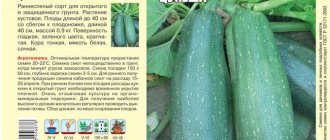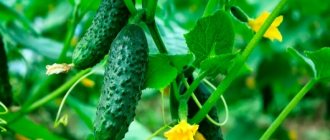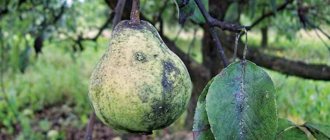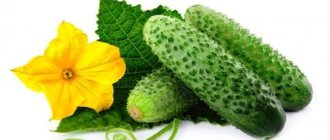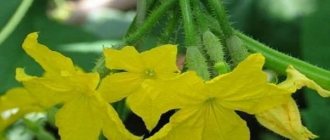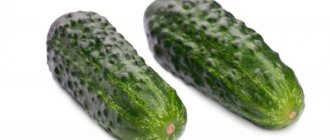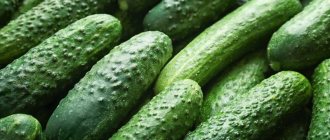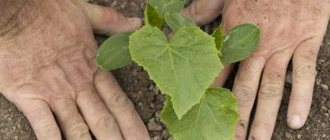Cucumber variety Zozulya F1: description of the variety, photos, reviews, planting and care, growing a hybrid
Cucumbers, along with tomatoes, are the most popular vegetable crops, which are grown in almost all summer cottages. Today, more than 2,500 varieties and hybrids of cucumbers are known, and making a choice in favor of specific varieties is sometimes difficult even for experienced vegetable growers.
This article will talk about the hybrid cucumber Zozulya f1, its main advantages, productivity, diseases and pests, as well as the nuances of growing this vegetable crop.
The content of the article:
1. History of creation 2. Characteristics and description 3. Productivity of the Zozulya cucumber variety 4. Diseases and pests 5. Advantages and disadvantages 6. Planting seedlings 7. Further care of Zozulya cucumbers 8. How to feed plants 9. Reviews of the Zozulya cucumber
Harvesting and storage
Harvesting takes place daily. This way, a lot of ovaries will be formed and the yield will be maintained for a long time. Zozulya can be stored for a long time. Ripe fruits can last up to 15-17 days in the refrigerator. If stored in a cellar, then only in boxes. If you add sand to the bottom, the shelf life will increase. Harvest can only be washed when directly used.
The description of f1 cucumbers is not much different from other cucumbers, even though it is a hybrid. The variety has many more positive characteristics than negative ones. Productivity is average but long lasting. The taste of cucumbers is not bitter if proper care is taken.
History of the variety's creation
Cucumber Zozulya F1 has been known to Russian vegetable growers for more than 40 years
- he was bred by Russian breeders Kudryashov, Mukhin and Skachko, working at the vegetable station named after. V. I. Edelshtein. When breeding the Zozulya cucumber, varieties of this vegetable crop with different genetic codes were crossed.
The Zozulya variety was submitted for inclusion in the State Register at the end of the third quarter of the last century and after tests in 1977 it was entered into the State Register of the USSR. The variety is recommended for cultivation in greenhouses in almost all regions of Russia and the Union republics (currently the CIS countries).
Cucumber Zozulya F1 - photo
Appearance
The appearance of the Zozulya cucumber does not quite correspond to the generally accepted ideal: in most cases, people believe that the most delicious cucumbers must be medium-sized and with obvious thorns. Zozuli fruits are quite long, and thorns are not typical for them. In terms of color, this is a classic green cucumber, often with subtle light longitudinal stripes.
Light stripes on long cucumbers are barely visible, and sometimes they are not visible at all
On bushes, fruits most often hang in clusters or bunches, and, since they are of impressive size, they thereby create the visual effect of high yield.
Zozulya cucumbers rarely hang one at a time, usually a whole bunch
Cucumber Zozulya: characteristics and description of the variety
The cucumber hybrid Zozulya belongs to the parthenocarpic type
Therefore, its flowers pollinate themselves, without requiring the presence of bees or the efforts of vegetable growers. A large number of ovaries are formed on the lashes of this plant, the number of which does not depend on changes in weather conditions and does not require the presence of pollinating insects.
On a note!
Zozulya cucumbers are an early ripening variety - approximately 1.5 months pass from the moment the seed material germinates to the first harvest.
And the usual ripening period for most other early-ripening cucumbers is at least 2 months. Thanks to such a rapid ripening period, Zozulya cucumbers are actively grown by those vegetable growers who grow early varieties of vegetable crops for further sale, as well as in regions with a short warm summer season (in the Urals, Siberia, the middle zone or the Leningrad region).
This hybrid has medium-length, well-leafed lashes. When grown in greenhouse conditions, the Zozulya cucumber is tied to trellises.
In this case, it is easier to care for the bushes and also to collect ripening fruits. The flowers are collected in inflorescences of 5-9 pieces each. As a result, cucumbers ripen simultaneously in large quantities.
Ripe cucumbers of the Zozulya variety are elongated, cylindrical, approximately equal and even. The length of a ripe Zozulya cucumber can reach 16-25 cm, and its weight can range from 165 to 200 g.
The skin of the fruit is dense, crispy, on its light emerald surface longitudinal stripes of a lighter shade are clearly visible, as well as rare small tubercles with dark spikes.
The pulp of Zozulya greens is compact, elastic, with a characteristic crunch and a sweet taste, without bitterness.
Photo of Zozulya cucumber
Collected Zozulya cucumbers are distinguished by their versatility - they are used for preparing salads and snacks, canning, and can also be pickled. Even after heat treatment, the cucumbers remain crispy and elastic.
The harvested crop tolerates transportation well over long distances, without losing its taste and presentation, and has good shelf life.
Features of cultivation
Planting and care of Zozulya in a greenhouse
Zozulya cucumbers are early ripening and self-pollinating, so they can be grown in greenhouse conditions in any region of Russia. They are even suitable for cultivation in Siberia.
Important! This is a hybrid, so seeds must be purchased from the originator.
Zozulya cucumbers can be grown using two methods: seedless and seedling. The second method is more complex, but makes it possible to get an earlier harvest.
When and how to plant cucumbers for seedlings
When growing the Zozulya cucumber variety, you must remember that early seedlings will freeze when planted, and later will delay fruiting.
Therefore, it is necessary to correctly calculate the timing of planting ready-made seedlings, which depend on the type of greenhouse:
- heated - from the beginning of March;
- unheated made of film or glass - from mid-May.
From this period it is necessary to count back 3-4 weeks. This will be the optimal time to sow seeds for seedlings.
You can grow about 10-15 seedlings on a windowsill. To grow cucumber seedlings, use peat pots or 250 ml plastic cups. Sowing of seeds is carried out according to the following algorithm:
- The soil in the cups is well moistened and 2 seeds are placed on top.
- They are sprinkled with a 1-2 cm layer of soil.
- Water with warm water from a spray bottle.
- The containers are covered with film and left on the windowsill. Indoor air temperature should be kept within 25-28oC.
- After 7 days, the first shoots should appear.
- Leave 1 sprout in each pot, removing the weaker ones.
- The film is removed.
- In the room, the air temperature is reduced to 24 degrees during the day, and to 18 degrees at night.
Caring for seedlings is not difficult. Regular watering and additional lighting are required. If necessary, you can apply fertilizer once.
After 3-4 weeks, adult seedlings are transferred to the greenhouse. Plants are planted in holes at a distance of 30 cm from each other. Leave 50 cm between rows. This works out to 1 square meter. m 2-3 plants.
Seedless method
The soil in the greenhouse should warm up to at least +12°C, and the air temperature should not be lower than +15°C. In most regions of the country, this temperature is observed after April 20.
The greenhouse is installed on a flat and sunny area, away from trees, so that the soil and air warm up faster. The soil mixture is prepared from 5 parts peat, 2 parts black soil and 3 parts compost. It is placed on the beds in a layer of 20 cm. Before sowing the seeds, the soil is watered with hot water from a watering can, adding potassium permanganate to it at the rate of 3 g of the product per 10 liters of water.
Most often, seeds from the originator are sold already treated, so they just need to be awakened. The seed material is placed on damp gauze and kept warm for 3 days. During this time, the sprouts should hatch.
After this, holes are made in the beds, leaving a distance of 30 cm between them. 50 cm is left between the rows. A handful of compost and 0.5 tsp are added to the holes. superphosphate and potassium salt, and also pour in 0.5 liters of warm water. After the liquid is completely absorbed, 3 seeds are placed in each hole and sprinkled with loose soil. Subsequently, you will need to leave 1 of the strongest sprouts in each hole.
Diseases and pests
The cucumber hybrid Zozulya is highly resistant to most diseases that affect other varieties of this vegetable crop.
Zozulya has the highest resistance to the following diseases:
- root rot;
- olive spot;
- cucumber mosaic virus.
All these diseases most often appear in crops growing indoors, which is why this hybrid is so valuable, which grows well in a greenhouse and is not affected by all of the above diseases.
Cucumber varieties!
Meringue F1 Cucumber Connie Cucumber Aragats
Main characteristics
The advantages of the hybrid include:
| Characteristic | Indicators |
| Ripening time | Early ripening: fruiting begins on the 40-45th day after mass germination |
| Productivity | In heated greenhouses for the first month - 8-16 kg/m2, for the season - more than 40 kg/m2 with a marketable product yield of 85% |
| Plant compactness | The main shoot is medium-sized, the branching is weak, self-regulating |
| High taste qualities of greens | Mainly for salad purposes, but suitable for pickling and canning |
| Disease resistance | Not susceptible to olive blotch (cladosporiosis) and cucumber mosaic virus, tolerant to root rot |
Read more about the characteristics of the variety below.
Advantages and disadvantages
The main advantages of the Zozulya cucumber include:
- large tasty greens;
- self-pollinating flowers;
- the presence of pollinating insects is not required for the formation of ovaries;
- high productivity;
- early ripening of greens;
- the possibility of growing almost throughout the entire territory of Russia;
- high resistance to most diseases characteristic of other cucumber varieties;
- the versatility of the collected fruits.
Zozulya cucumber has practically no disadvantages. It should only be noted that this cucumber is a hybrid, so you cannot collect seeds for further planting - they do not have parental characteristics.
Main positive and negative aspects
Zozulya cucumber has more advantages than disadvantages. Among the positive characteristics:
- High level of productivity.
- Easy to grow, as the variety is unpretentious.
- High level of tolerance to various diseases.
- Versatility of use.
- Long fruiting period.
- Long storage period.
- Excellent transportability.
The disadvantages are:
- Poor yield in open ground.
- Prickly.
Cucumber Zozulya: planting seedlings
You need to buy seeds of the Zozulya hybrid in specialized stores, choosing seed from well-known agricultural companies - seed producers. In this case, you can be sure that the planting material will be almost 100% viable, having undergone pre-sowing treatment. As a result, such Zozulya cucumber seeds will need to be soaked before sowing for germination, and then planted in a permanent place in the greenhouse.
In order to get the harvest of these cucumbers early, many vegetable growers pre-grow Zozulya cucumber seedlings at home.
Soil for planting can be purchased at a specialized store, or you can prepare a nutrient substrate yourself. In this case, garden soil, river sand and high-moor peat are mixed in a ratio of 1:1:1. Before use, the soil mixture prepared at home should be calcined in the oven for half an hour at a temperature of about 180 degrees, then cooled. And only after this can the soil be laid out in pots.
Description
Zozulya F1 cucumbers are a hybrid form obtained by crossing parthenocarpic lines of European and Asian origin. Improved vegetative and generative characteristics appear only in the first generation of hybrids, marked with the designation “F1”.
The hybrid has the property of parthenocarpic development of ovaries and is able to do without pollination
In parthenocarpic cucumbers, the ovaries develop without fertilization, but it has been noted that in low light conditions during early planting, “Zozulya F1” demonstrates more active fruiting when pollinated by insects. This feature should be taken into account primarily when industrially growing cucumbers in heated greenhouses, where seedlings are planted in late February - early March. Bees are used for only 2-3 weeks, while in the lower and middle sections of the central stem the starting parthenocarpy is too weak. If there are no male flowers on the plant, single plants of pollinating varieties are planted nearby.
In a number of greenhouse farms, with short-term pollination of plants of this hybrid by bees, an increase in early yield by 2.7-3.5 kg/m2 was observed
It makes no sense to organize pollination by Zozuli F1 bees on personal plots, since seedlings are planted in greenhouses in April-May, when the days are long enough and the light levels are high. Under such conditions, parthenocarpy becomes active and the greens fill up together.
Plants of this hybrid are characterized by a purely or predominantly female type of flowering, differ in the average length of the main stem, a small number of lateral shoots and a tendency to self-regulate branching. The bushes require virtually no shaping.
“Zozulya F1” is a medium-fruited plant – the greens are 14-25 cm long
Zelentsy are medium-sized (14-25 cm in length, 4-5 cm in diameter), weighing 150-300 g, have a cylindrical shape, green color with pronounced light spotting and long longitudinal stripes. The surface at the base of the green plant is smooth, and then it is medium-tubercular with sparse white pubescence. Fruits for salad purposes: have the highest taste, do not taste bitter, do not become rough and do not turn yellow. Typically, greens are harvested before reaching technical maturity (smaller), and many gardeners consider them suitable for pickling.
The variety is also highly valued for its marketable yield and abundant fruiting, which has the following indicators:
- friendly and earlier: starts from the 40-45th day after full germination, the yield in the first month reaches 8-16 kg/m2;
- stable and long-lasting: in unheated spring greenhouses they get 15-20 kg/m2 per season, in greenhouse complexes - 40 kg/m2 or more.
The yield of marketable products is about 85%, while greens tolerate long-term storage and transportation well.
In the photo - packages with seeds of the hybrid variety of cucumbers "Zozulya F1" from various manufacturers
The wide popularity of the variety has led to the emergence of a large amount of counterfeit seed material. Massive uncontrolled breeding of this hybrid led to a decrease in its quality as a whole, but at the same time it became a good incentive for the author-breeders to work. Based on Zozulya F1, they created new and improved analogue hybrids that have greater endurance and increased resistance to various diseases:
| Hybrid name | Diseases to which the hybrid is resistant | Diseases to which the hybrid is tolerant |
| "Virenta F1" | Powdery mildew, olive blight, cucumber mosaic virus (VOM-1) | Downy mildew |
| "Emelya F1" | Olive spot, VOM-1 | Powdery mildew and root rot |
| "Makar F1" | Olive spot, VOM-1 | Root rot |
| "Martha F1" | Olive spot, VOM-1 | Root rot |
| "Mill F1" | Olive spot, VOM-1 | Powdery mildew, root rot |
| "Real Colonel F1" | Olive spot, VOM-1 | Powdery mildew, root rot |
| "The secret of the F1 company" | Olive spot, VOM-1, powdery mildew | Downy mildew, root rot |
The following video will tell you about checking the quality of seeds of the hybrid variety of cucumbers “Zozulya F1”:
Among the positive qualities of this variety, it is important to note the relative cold and shade tolerance, wide ecological plasticity (including on saline soils), resistance to olive blotch and BOM-1, tolerance to root rot
Further care for Zozulya cucumbers
Seedlings of Zozulya cucumbers are transplanted into previously prepared beds in a greenhouse or open ground, which are pre-fertilized with humus and mineral fertilizers containing phosphorus and potassium.
No more than 4 cucumber plants should be planted on each square of area.
After transplanting the cucumber bushes to a permanent place in the greenhouse, they should be watered daily until the plants acclimatize to the new place. In the future, it is recommended to water growing cucumbers every other day. If the weather is hot and dry, then the amount of watering is increased.
After watering, be sure to loosen around the bushes, trying not to damage their roots.
. Loosening allows you to remove the crust on the soil surface, which prevents moisture and air from entering the soil. At the same time as this procedure, weeds should be removed, especially when the cucumber bushes are still small.
When the cucumber vines become large enough, they are tied to supports. In greenhouse conditions, it is better to use trellises as supports for Zozulya cucumbers.
Growing early varieties using seedlings
Growing by seedlings speeds up fruit production by an average of two weeks. To obtain an early harvest, choose the following varieties of cucumbers:
- April;
- Hermann;
- Zozulya;
- Cascade;
- Finger;
- Chinese (farmer's or "Chinese snakes") and others.
All of the above varieties of cucumbers have good varietal qualities and productivity.
Cucumber Zozulya F1: reviews from those who planted
Olga, 45 years old, Saratov region: I have been planting the hybrid Zozulya in my garden for several seasons. The bushes of this cucumber have never suffered from any disease and are distinguished by their early ripening period. What I collect is enough for food, I also make a lot of twists for the winter. My family likes this variety of pickled crispy greens, so I seal these cucumbers in three-liter jars in large quantities for the winter.
Natalya, 50 years old, Novosibirsk region: It is best to grow cucumbers in our region only in greenhouse conditions. I tried many varieties, but settled on the Zozulya hybrid. This variety is perfect for growing indoors; it does not require pollinating insects, since the variety is parthenocarpic. I plant the seeds directly into the greenhouse in the second half of May and within a month I harvest them in buckets.
The Zozulya hybrid does not require special care, usually planting seed material in early May, the peak yield occurs in the last days of June - early July
. The harvested crops are quite large, so summer residents not only consume them fresh, but also make a sufficient amount of preparations for the winter.
Recently searched:
Reviews
Gardeners speak positively about the Zozulya hybrid and recommend growing it to those who are willing to devote time and effort to caring for plants.
Galina, Belgorod : “We grew these cucumbers last summer, the salads were incredibly tasty. I am very glad that I was able to find this hybrid. But at first I couldn’t grow them; there were always some problems. Either the yield is small or the fruits are small. As soon as I started paying closer attention to the plants, everything immediately improved. I am very glad that I can enjoy such a delicate taste.”
Natalya, St. Petersburg : “I plant seeds in open ground every year. My first fruits grow long and very even. When the bush stops bearing fruits, they already appear crooked. But in general, this hybrid is recommended for greenhouse planting.”
Elena, Moscow : “I use these cucumbers only for salad, because they are large, long, and most importantly, they grow juicy. When we planted them and they began to grow and set fruit, we were immediately glad that there would be a lot of cucumbers. This turned out to be true, we planted a few seeds, there was a lot of fruit, and we reaped a good harvest.”
Preparing seeds for sowing
To obtain high-quality seedlings, it is necessary to choose suitable planting material. There are varietal seeds and hybrids.
Hybrids (the packaging is marked with the abbreviation “F1”) are self-pollinating, disease-resistant, and are mostly intended for greenhouses.
Reference ! The varieties are adapted to open ground, less demanding, but have lower yields compared to hybrids.
- Before sowing, select large, full-bodied seeds.
- Then keep them in the potassium permanganate solution for 20 minutes.
- Then rinse with water.
- Instead of potassium permanganate, use a two percent solution of hydrogen peroxide or a solution of boric acid (half a teaspoon of powder per glass of water).
- To separate non-germinating seeds, they are germinated until roots 0.5 cm long appear, placing them in a humid environment. For this, wet gauze or cloth folded in 2-3 layers, cotton wool, and sawdust are also used.
If you plan to plant seedlings in open ground, it is advisable to harden the seeds . Soaked seeds, placed in a damp cloth, are stored in the refrigerator for two days at a temperature of 0 to 2 degrees. After hardening, planting is carried out.
Read more about preparing seeds before planting.

